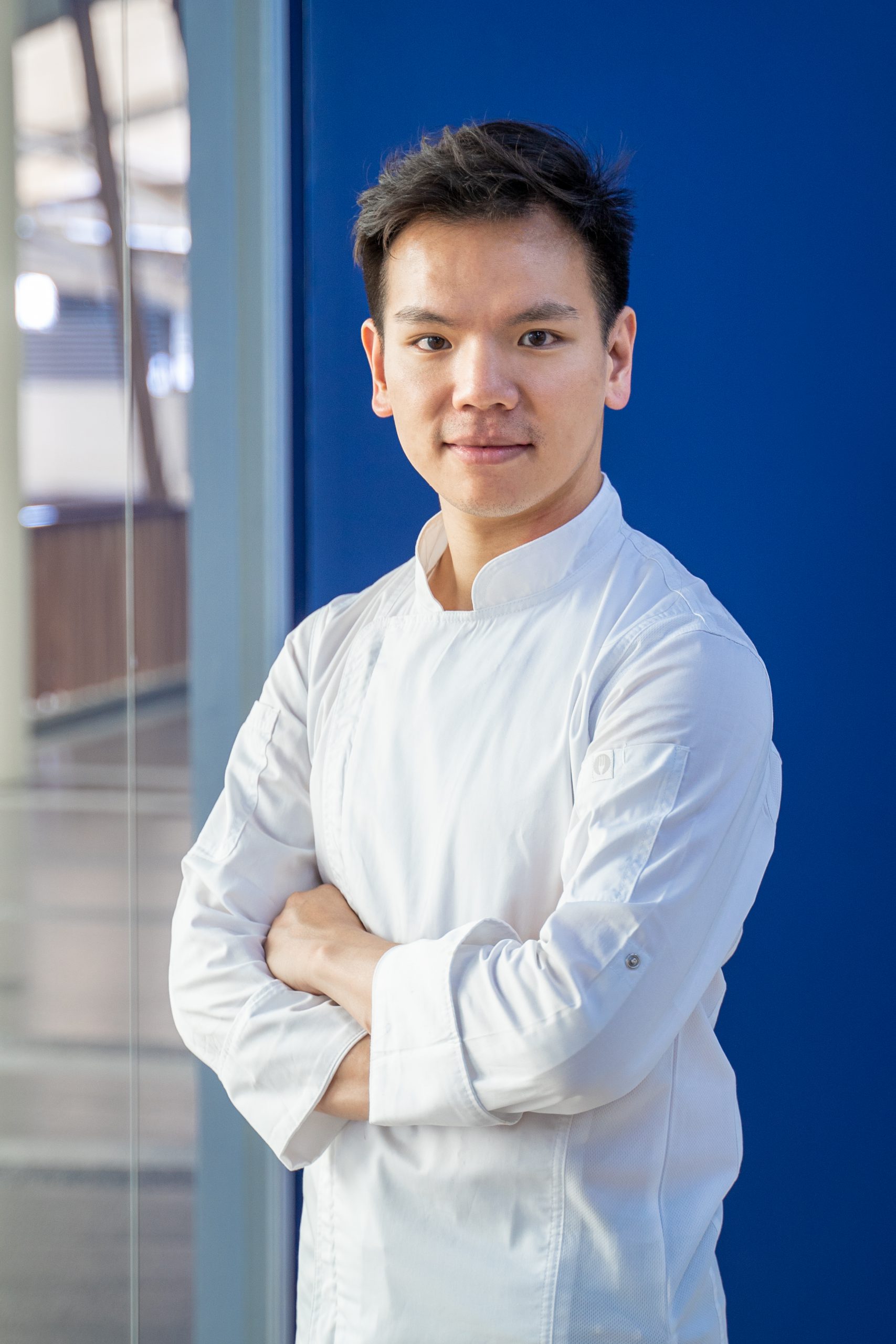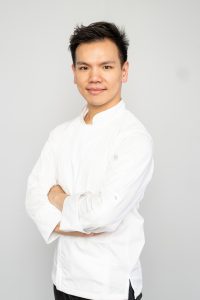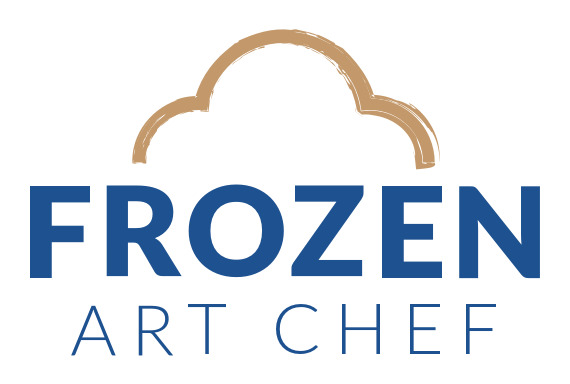
Young and talented, Jeffrey Wang [Jiachen Wang 王家承] is one of the most promising Taiwanese pastry chefs.
Locals know him because, after specialising in French Pâtisserie, he used to be the Executive Pastry Chef at SPOT, a famous American restaurant in Taipei City.
Well, there’s much more to discover. With over a decade of pâtisserie experience, Chef Jeffrey worked alongside some of the most renowned international pastry chefs in Taiwan and he held several live demos at international shows. He was the first runner-up, Mousse Division at the 2015 Taiwan Gateaux’s Cake Contest. He contributed to expand the territory of 85C Bakery Café, a famous Taiwanese chain store, in the US. After working there for one year, he moved to France to pursue cutting-edge pâtisserie creativity at the Ecole Gastronomique Bellouet Conseil De Paris. In Taipei City Chef Wang co-owns the Pâtisserie Fla Fla Tu Tu and he just inaugurated Volute Croissant, a new brand concept especially dedicated to viennoiserie products. His skills and techniques are con tenuously honed. Jeffrey doesn’t stop pioneering new confections and re-inventing the way traditional pastries and desserts are made.
If the passion and love for pastry arts began in his early teens, he is now recognised by his peers (check his Instagram profile @tpcremix1985) and the media for his creativity and excellence. Pastry Art is reaching high levels in Taiwan, so Frozen Art Chef decided to dedicate to him the September Interview and unveil how Chef Jeffrey Wang keeps pursuing and pushing the boundaries.
1. Chef Jeffrey, how was the start of your career?
Everything began by chance. I wasn’t dreaming to become a pastry chef when I found a part-time job at AMO Bakery. I was in my teens, I thought it would have been “just a job”.
Well, it actually changed my life. I immediately developed a huge passion for my work. During my University years, I wanted to learn more about pastry-related-skills, so I decided to do my internship in Hospitality. I started working at the Sheraton Grand Taipei; at the beginning I had no salary. Those days weren’t that easy but this experience convinced me that pastry art was exactly what I wanted to master. I followed one of the chefs met during my internship at MAISON KAYSER, where I deepened my knowledge about French pastries. All the recipes were written in French or English language and, in order to keep up with the chef’s footsteps, I began “studying” in the storage room after work. My language skills weren’t great, so I decided to take note of the name of every puree and ingredient used at the shop. All of them had English and French labels, so I had to translate and memorise.
Even during my days-off, I used to go to the library and do research. I wanted to learn the traditional pastry methods and processes. As the technology at that time was not as advanced as it is now, I could only rely on these methods to improve my skills. Pierre Hermé, the Architect of Taste, was my biggest inspiration at that time.
2. Pastry Chefs are setting high standards in Taiwan, and you are a Pastry Instructor now. Tell us more.
In 2015, pastry courses started becoming popular in Taiwan and I was asked to teach. I was young and I put my heart in it. I insisted on making my students do the simplest things at their best. My first lessons focused on the most essential methods, so that students could absorb them.
While teaching, I met great pastry chefs. Let me recall Ronald Lee, a great Chinese Pastry Chef who taught me what a real french dessert is. New ideas were coming out during our interflows but it was not enough. I still had to satisfy my thirst for knowledge. So, I resolutely decided to suspend of all my work and let myself fly abroad to learn more. When I returned to Taiwan, I applied the new techniques with my personal ideas. My pastries turned out to be more creative, and it was a pleasure to convert my innovation into new courses and share it with Taiwanese chefs who share the same passion.
In 2018, I was invited to give lectures in foreign countries. During my travels I met even more skilled pastry chefs; I got a lot of new ideas and techniques through them. I have been committed to bring skills worth learning back to my birthplace. I started inviting pastry chefs from overseas to show their exquisite skills in Taiwan. Perhaps that’s my biggest contribution to desserts in Taiwan: “motivate everyone in learning new skills, so that Taiwan’s pastry industry can continuously grow and improve”.
3. What about your relationship with Frozen Desserts?
I couldn’t learn in Italy (eg. at the Carpigiani Gelato University) the most orthodox frozen dessert recipes. I started by using my knowledge of pastries instead. I kept practising and asking my great colleagues where to improve. I experimented with different proportions in order to make frozen desserts with great texture and flavour.
My relationship with frozen desserts reminds me the experience of a baby who is learning to walk. The baby learns to walk step by step through continuous trial and practice and with the guidance of his parents. When I prepare my frozen dessert recipes, I also often think of when we were young. We certainly did many efforts to learn whatever we were interested in. Of course, a great guide is important but, in the end, you will succeed only if you practice hard. It is difficult to take the first steps, but then things become smooth.
Frozen desserts can definitely be combined with bakery and pastry creations. By mixing up different elements you will collide with different sparks. I like it very much in this way!
4. Would you share with us one of your latest “sparkling” recipes?
I’m pleased to share with all the Frozen Art Chef lovers my “Chestnut” recipe. The fall season just began. It has been a perfect addition to my menu.
5. Your advice for all the young students who want to become a successful pastry chef?
The secret of being successful is to constantly improve yourself, no matter what industry you are in. Maybe you will suffer a lot in the dessert industry, but by stumbling I have grown stronger. So young people, don’t be afraid to endure hardships. “Prepare yourself to be ready anytime and open your hands to meet your own opportunities when they come”.
I am not a pastry chef with a lot of experience in competitions, I believe that through non-stop improving to create better works, everyone has his/her own suitable path. But I never forget the original purpose of every pastry competition: “aim to perfection”. Only by making every product carefully, you can be called a good pastry chef.
6. Lastly, which trends do you foresee in Frozen Desserts now?
Less-sugar and low-fat must be the future trends. My hope is to use natural ingredients without adding too many chemicals and make the same tasty frozen desserts. I keep testing my recipes by changing proportions and adding healthy ingredients. I want to provide the best flavour.
The remaking of milk-base frozen desserts is not only focused on vegan or low-fat consumers. It’s about being open-minded and create with alternatives.
We all know that animal husbandry is harmful to the environment, but it is also very difficult to not use dairy products in pastry products. I don’t stop exploring replacements with nuts milk, avocado, soya milk, coconut milk, coconut oil, cocoa butter, fresh fruit… There is a great selection of ingredients indeed.
Gourmet Grubb‘s frozen dessert products even include insect milk. I am very interested in this new concept. I’m sure that Taiwanese consumers will put aside their existing thoughts and they will be willing to accept diversified creations. We all have to play our part in this environmental challenge.



